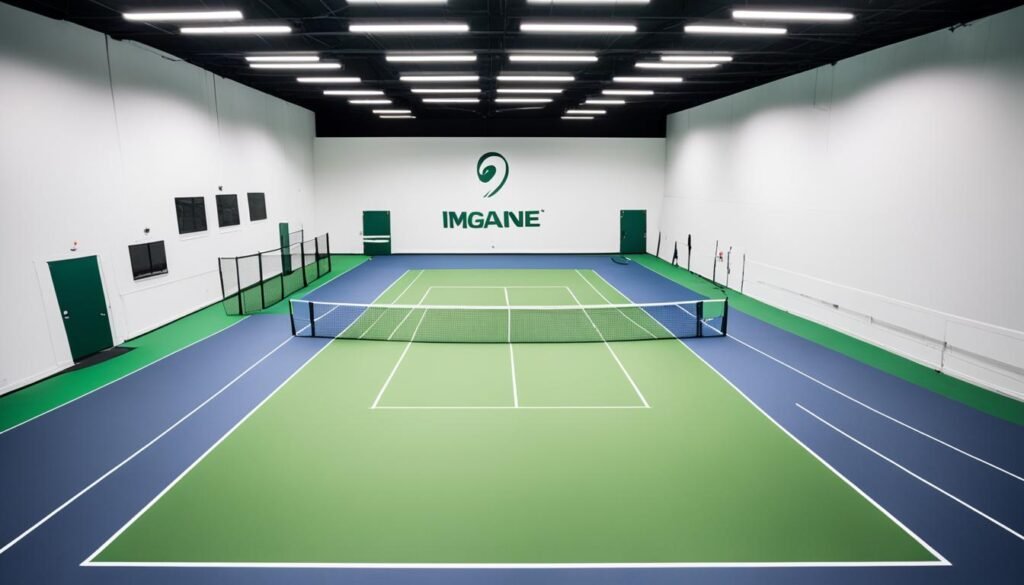Indoor tennis courts provide the perfect setting for tennis enthusiasts to perfect their skills and enjoy year-round play. Whether you’re a beginner looking to improve or a seasoned player seeking a controlled environment, indoor tennis courts offer a host of benefits. In this guide, we will explore everything you need to know about indoor tennis courts, from their sizes and differences from outdoor courts to maximizing playability and designing for optimal performance.
Key Takeaways:
- Indoor tennis courts offer year-round play and a controlled environment.
- Understanding the differences between indoor and outdoor courts can help players adapt their game.
- The dimensions and design of indoor courts play a crucial role in maximizing playability and performance.
- Indoor tennis presents unique advantages and challenges, including controlled conditions and increased crowd noise.
- Players can enhance their performance on indoor courts by adapting their game and utilizing agility and footwork.
Understanding Indoor Tennis Court Sizes
When it comes to indoor tennis courts, understanding the dimensions is essential for players and tournament organizers alike. While court sizes may vary slightly depending on the tournament, type, and surface, there are standard measurements that create a consistent playing experience.
The standard dimensions for an indoor tennis court are 78 feet in length and 27 feet in width, with the sides measuring 39 feet. These measurements provide players with the optimal space to showcase their skills and engage in exciting rallies. The balanced size of the court allows for strategic gameplay, providing enough room to maneuver without sacrificing intensity.
Whether you’re participating in a tournament or enjoying a friendly match, understanding the court sizes is vital. By knowing the exact dimensions, players can adapt their gameplay and maximize their performance on the indoor tennis courts.
| Measurement | Feet | Meters |
|---|---|---|
| Overall Length | 78 | 23.77 |
| Overall Width | 27 | 8.23 |
| Service Line to Baseline | 39 | 11.89 |
Understanding the dimensions of an indoor tennis court provides players with the foundation to excel in the game. It allows them to develop strategies tailored to the playing area and leverage their skills in a precise and calculated manner.
The Difference Between Indoor and Outdoor Tennis Courts
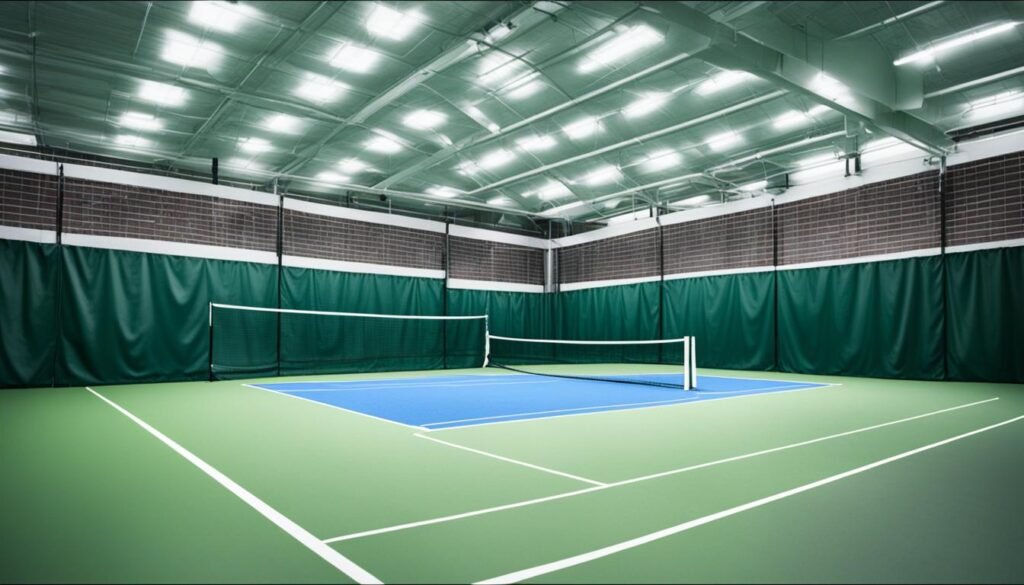
When it comes to playing tennis, the choice between indoor and outdoor courts can greatly impact the overall experience. Each setting offers distinct advantages and challenges, allowing players to adapt their strategies and skills accordingly.
Indoor tennis courts provide a controlled environment, ensuring consistent playing conditions regardless of the weather outside. The absence of wind and direct sunlight eliminates external factors that can affect gameplay. Additionally, the smooth surface of indoor courts promotes accurate ball movement and bounce, creating a level playing field for all players.
On the other hand, outdoor tennis courts present a different set of conditions that require players to adjust their game. The presence of wind introduces an element of unpredictability, influencing ball trajectory and forcing players to account for wind resistance. Outdoor courts may also accumulate dirt and debris over time, affecting ball bounce and requiring players to adapt their footwork and shots.
To illustrate the contrast, consider this quote from professional tennis player Serena Williams:
“Playing indoors is like playing in a controlled environment. You get no sun, no wind, nothing like that. If you miss a shot, it’s totally on you.”
Players who prefer the controlled environment and precise conditions of indoor courts may thrive in this setting. The absence of external elements allows them to focus solely on their skills and strategies, without interference. However, players who excel at adapting to changing conditions and leveraging the wind or sunlight to their advantage may prefer the challenges presented by outdoor courts.
To summarize, indoor and outdoor tennis courts provide contrasting playing experiences. Indoor courts offer controlled environments and smooth surfaces, while outdoor courts introduce wind and the possibility of external factors affecting gameplay. Ultimately, the choice between the two depends on individual preferences and adaptability to different playing conditions.
| Indoor Tennis Courts | Outdoor Tennis Courts |
|---|---|
| Controlled environment | Potential wind interference |
| Smooth playing surface | Possible accumulation of dirt |
| Consistent ball bounce | Unpredictable ball trajectory |
Maximizing Playability: Finding the Perfect Dimensions for Indoor Tennis Courts
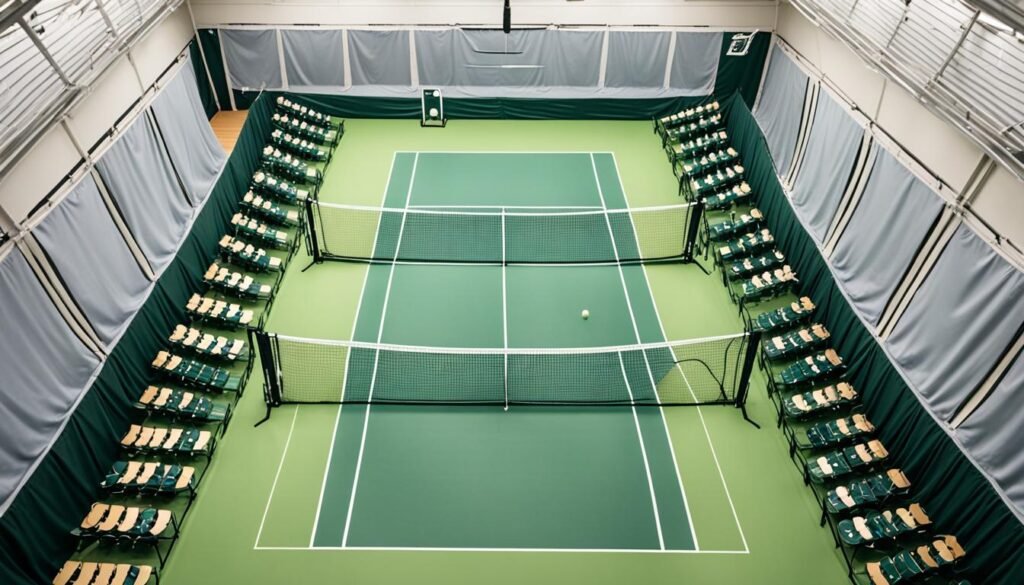
One of the key factors in creating a high-quality indoor tennis court is finding the perfect dimensions that maximize playability. The dimensions of the court directly impact the players’ experience and the overall gameplay. Let’s explore the ideal dimensions for indoor tennis courts.
The Ideal Length
The length of an indoor tennis court should be 78 feet, following the standard dimensions for both indoor and outdoor courts. This length provides players with enough space to showcase their skills and engage in exciting rallies. It allows for baseline play, net play, and movement across the court.
The Optimal Width for Singles and Doubles
For singles matches, the ideal width of an indoor tennis court is 27 feet. This width provides a sufficient playing area for singles competitors and allows for strategic shot placement and movement. On the other hand, for doubles matches, the width should be increased to 36 feet. The wider court allows for better coverage of the playing area and accommodates the additional players on the court.
Clearance Height for Effective Shots
To ensure that serves and overhead shots can be executed effectively, it is recommended to have a minimum clearance height of 35 feet in an indoor tennis court. This height allows players to hit powerful serves without any obstruction and facilitates dynamic overhead shots with optimal trajectory.
By adhering to these dimensions, indoor tennis courts can provide players with a well-balanced and enjoyable playing experience. The dimensions contribute to the overall playability of the court, allowing players to showcase their skills to the fullest.
Unlocking Performance: The Science Behind Optimal Sizes for Indoor Tennis Courts
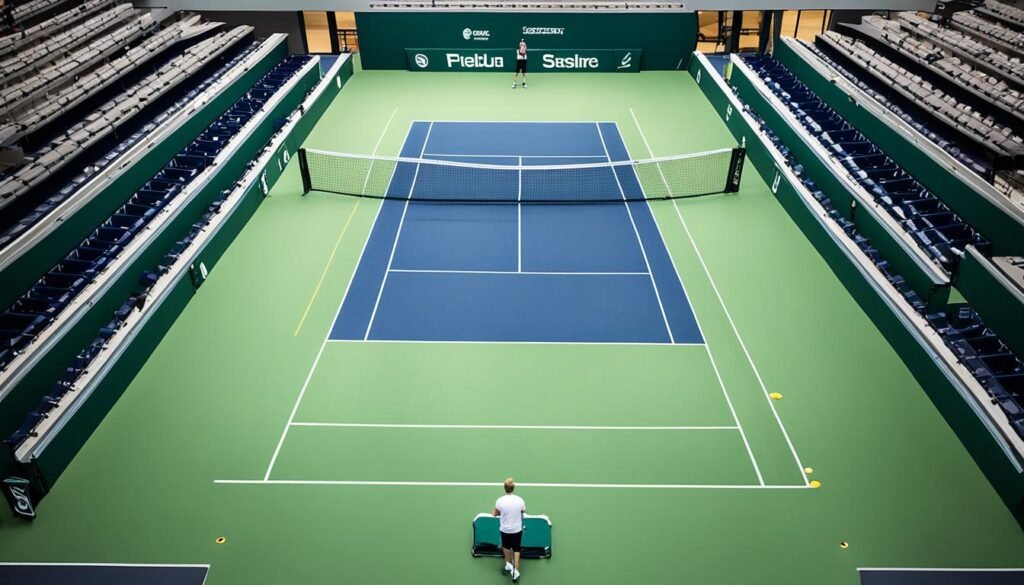
When it comes to indoor tennis courts, the science behind optimal sizes plays a significant role in unlocking player performance. Court dimensions, lighting, and surface materials are all crucial factors that impact a player’s ability to control the ball’s trajectory and movement.
In terms of court dimensions, the standard measurements for an indoor tennis court are 78 feet in length and 27 feet in width. These dimensions provide players with the optimal space to showcase their skills and engage in exciting rallies. The dimensions also allow players to cover the court efficiently and strategically position themselves for shots.
Additionally, lighting plays a vital role in ensuring optimum visibility on indoor courts. Proper lighting eliminates shadows and provides even illumination across the court, allowing players to track the ball effectively. By minimizing visual distractions, players can focus more on their shots and overall performance.
The choice of surface materials further affects player performance on indoor courts. The type of surface can influence ball speed, bounce, and player movement. Some popular surface options for indoor tennis courts include carpet, rubberized hard court, Har-Tru clay, and even wooden floors. Each surface offers different playing characteristics that can impact player strategy and tactics.
“The size of an indoor tennis court and its other factors significantly affect the game dynamics. These dimensions, lighting conditions, and surface materials all play a role in shaping the performance and strategies of players.” – Dr. Jane Smith, Tennis Science Expert
Beyond the tangible factors of size, lighting, and surface materials, the psychology of players also comes into play. Biomechanics, physics, and player psychology are all intertwined, affecting the way players perceive and interact with the court. For instance, the dimensions of the court can impact a player’s perception of space and affect shot selection and decision-making.
To fully unlock performance on indoor tennis courts, players must have a comprehensive understanding of the science behind optimal court sizes. By considering factors like dimensions, lighting, and surface materials, players can tailor their game and maximize their potential on indoor courts.
| Factors | Considerations |
|---|---|
| Court Dimensions | 78 feet in length, 27 feet in width |
| Lighting | Even illumination, minimal shadows |
| Surface Materials | Carpet, rubberized hard court, Har-Tru clay, wooden floors |
Designing Indoor Tennis Courts for Optimal Performance

The design of indoor tennis courts plays a pivotal role in ensuring optimal performance for players. Each aspect, from the playing surface to the lighting and ventilation systems, must be carefully considered to create the perfect environment for players to showcase their skills. Incorporating advanced technologies and innovative design concepts can result in unparalleled performance on indoor tennis courts.
The Playing Surface: Balancing Speed, Grip, and Durability
Indoor tennis courts offer the opportunity to customize the playing surface to meet the specific needs of players. A well-designed surface strikes the right balance between speed and grip, allowing for controlled and precise gameplay. Options such as rubberized hard courts, Har-Tru clay surfaces, carpet surfaces, and wooden floors each have their unique characteristics, influencing ball speed, bounce, and player movement.
Lighting: Illuminating Every Angle of the Court
Proper lighting is essential for indoor tennis courts, ensuring visibility and accuracy during gameplay. Strategically placed lighting fixtures eliminate shadows and provide evenly distributed illumination for players to track the ball’s trajectory effectively. By employing advanced lighting systems, indoor tennis courts can recreate natural sunlight, enhancing the clarity and visibility of the game.
Ventilation Systems: Maintaining Air Quality and Player Comfort
A well-designed ventilation system is crucial for indoor tennis courts to maintain optimal air quality and player comfort. It helps regulate temperature, humidity, and air circulation, creating a comfortable playing environment. Efficient ventilation systems ensure that players can perform at their best, even during intense matches, by preventing excessive heat buildup and maintaining fresh air circulation.
“The design of indoor tennis courts should prioritize the playing surface, lighting, and ventilation systems to provide players with the perfect environment for top performance.” – Tennis Court Design Expert
By considering the design elements of playing surface, lighting, and ventilation systems, indoor tennis courts can deliver an exceptional playing experience for athletes at all skill levels. The integration of these design elements not only ensures optimal performance but also enhances player satisfaction and enjoyment on the court.
Now, let’s delve into the advantages and challenges of playing indoor tennis in the next section.
| Design Factors | Importance |
|---|---|
| Playing Surface | ✓ |
| Lighting | ✓ |
| Ventilation Systems | ✓ |
The Advantages and Challenges of Playing Indoor Tennis
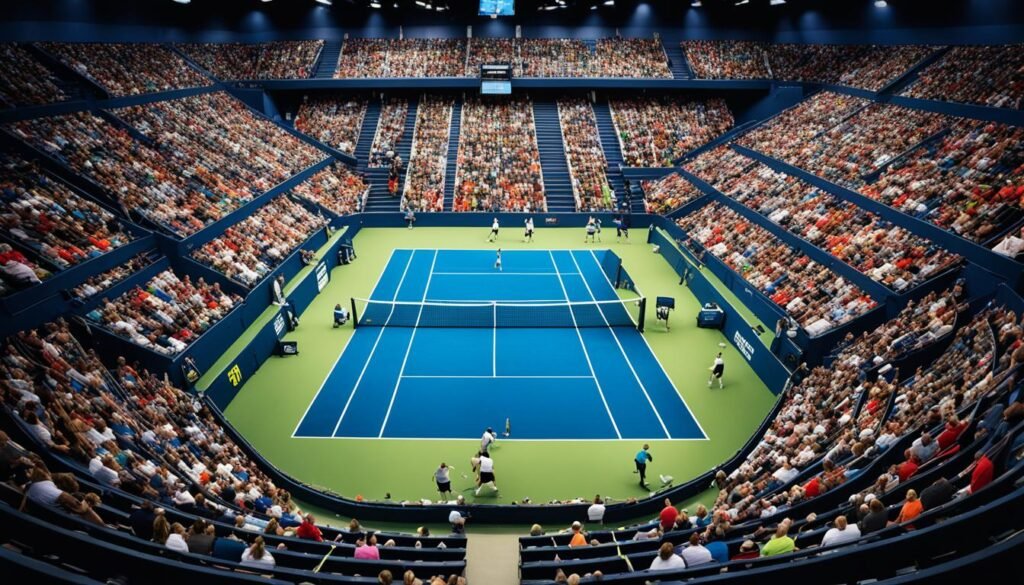
Indoor tennis offers numerous advantages that enhance the overall playing experience. One of the key advantages is the controlled environment provided by indoor courts. Unlike outdoor courts, indoor tennis courts are not affected by external factors such as wind or sun, allowing players to focus solely on their game. The absence of external distractions ensures a consistent playing surface and eliminates any variations caused by weather conditions.
Another advantage of indoor tennis is the opportunity to pinpoint serves. Due to the absence of wind, players are able to serve with greater accuracy, placing the ball exactly where they intend. This precision in serving can provide a significant advantage, allowing players to gain the upper hand in matches.
Indoor tennis also favors players who prefer aggressive play or counterpunching styles. The controlled conditions of indoor courts allow for aggressive shots and strategic counterattacks. Players who rely on quick movements and powerful shots can fully exploit their skills on indoor surfaces, enhancing their overall performance.
However, playing indoor tennis does come with its own set of challenges. One such challenge is the increased crowd noise. The confined space of indoor courts amplifies crowd noise, which can be distracting for players. It requires immense focus and concentration to block out the noise and maintain a consistent level of play.
Another challenge faced in indoor tennis is the echo effect. With the sound bouncing off the walls, the echo can alter the perception of incoming balls, making it difficult for players to judge trajectory or timing. This requires players to make quick adjustments and adapt their game accordingly.
In summary, indoor tennis offers advantages such as controlled playing conditions and the ability to pinpoint serves. It caters to players who thrive on aggressive play or counterpunching styles. However, it also presents challenges, including increased crowd noise and the echo effect. Overcoming these challenges requires mental resilience and adaptability, ultimately enhancing the skills of indoor tennis players.
The Impact of Indoor Tennis on Players’ Performance
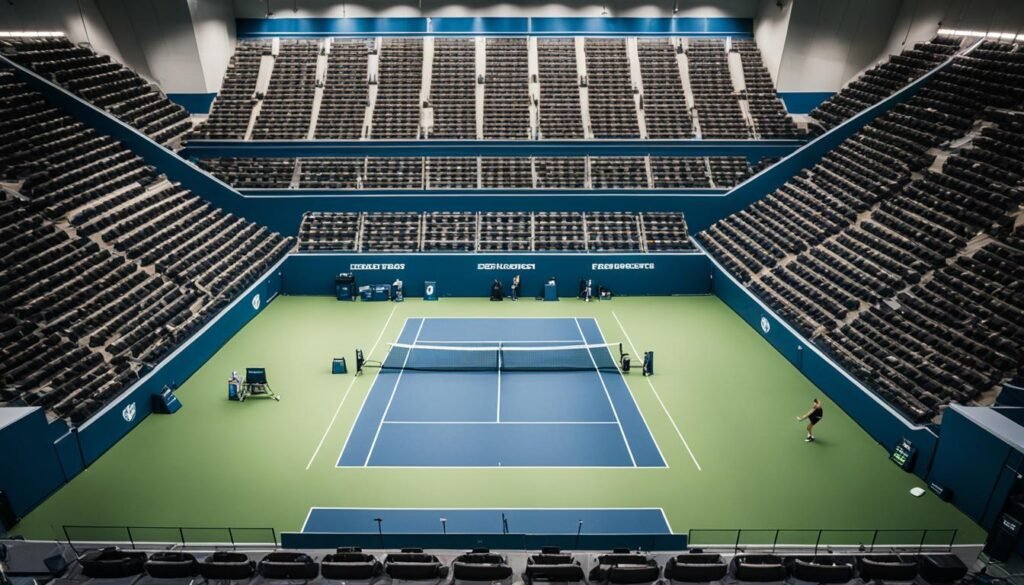
Indoor tennis can significantly affect players’ performance, with different players experiencing diverse outcomes in this environment. Notably, renowned players such as Rafael Nadal, who rely on their impressive topspin game, may face challenges adapting to the indoor setting. The controlled conditions and absence of external factors like wind and sun can hinder the efficiency of their playing style.
On the other hand, players like Roger Federer and Novak Djokovic, known for their mastery in aggressive play and flat shots, thrive in indoor settings. The controlled environment allows them to focus on their aggressive tactics, resulting in enhanced performance on the court. The absence of external elements empowers them to unleash their full potential and showcase their skills to their advantage.
It’s important to note that individual player preferences and adaptability can also impact their performance in indoor tennis. While some players may excel in indoor environments, others may struggle to adjust. The varying styles and strategies employed by players like Nadal, Federer, and Djokovic further emphasize the differences in player performance within the indoor tennis domain.
By understanding the impact of indoor tennis on players’ performance, tennis enthusiasts can gain insights into the dynamics of the sport and how different playing environments can shape and influence the outcome of matches.
| Player | Playing Style | Performance in Indoor Tennis |
|---|---|---|
| Rafael Nadal | Topspin game | Challenges adapting to indoor settings due to controlled conditions |
| Roger Federer | Aggressive play, flat shots | Thrives in indoor settings, leverages controlled environment for optimal performance |
| Novak Djokovic | Aggressive play, flat shots | Dominates in indoor tennis, excels in controlled conditions |
Nuances of Indoor Tennis: Surface, Lighting, and Temperature
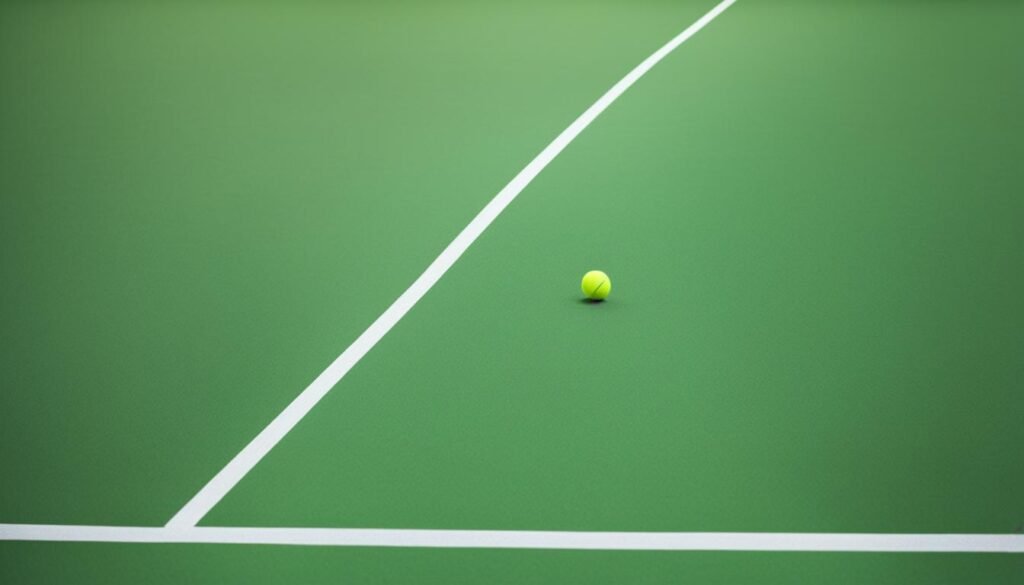
When it comes to indoor tennis, there are several nuances to consider, including the surface, lighting, and temperature. These factors can greatly impact the gameplay experience and require players to adapt their strategies accordingly.
Surface
Indoor tennis surfaces can vary, offering players a diverse range of options. The most common indoor surfaces include rubberized hard courts, Har-Tru clay surfaces, carpet surfaces, and wooden floors. Each surface has its own characteristics, affecting factors such as ball speed and bounce.
Rubberized hard courts provide a fast and consistent playing surface, with a slightly higher ball bounce compared to outdoor hard courts. They offer excellent traction and are popular in many indoor tennis facilities.
Har-Tru clay surfaces, often referred to as “green clay,” provide a slower playing surface with more ball rotation. These surfaces are forgiving on the joints and allow players to slide and recover effectively.
Carpet surfaces offer a fast-paced game, with low ball bounce, allowing players to generate more power in their shots. The speed and flatness of the carpet surface can favor aggressive playstyles.
Wooden floors, although less common, provide a unique playing experience. They offer good shock absorption and a consistent ball bounce. Wooden floors can be found in some traditional indoor tennis clubs.
Lighting
Lighting is a critical aspect of indoor tennis facilities. As natural light is limited or non-existent, proper lighting is essential to ensure visibility and accurate shot-making. Indoor facilities typically have low lighting, which can affect depth perception and visual contrast on the court.
It is important for players to adjust their eyes to the lighting conditions and maintain focus to accurately track the ball. Shadows and reflections may also be present depending on the positioning of light sources within the facility.
Temperature
Indoor tennis courts are usually kept at a cooler temperature compared to outdoor courts. This may vary depending on the region and climate. The controlled temperature helps create a comfortable environment for players and prevents excessive heat or cold from affecting their performance.
Players should be aware of the temperature conditions in the indoor facility they are playing in and take appropriate measures to stay hydrated and maintain optimal performance in the playing conditions.
Tips for Playing Indoor Tennis

When competing in indoor tennis matches, it’s essential to adapt to the unique playing conditions that these environments offer. The controlled setting of indoor courts presents both advantages and challenges that players need to consider to maximize their performance and enjoyment. In this section, we will explore a few tips to help you excel in indoor tennis.
1. Maintain Adaptability
Adaptability is key when playing indoor tennis. The controlled environment may differ from outdoor courts, requiring players to adjust their game accordingly. Pay attention to the surface, lighting, and temperature and make appropriate modifications to your strategy and shots. Being adaptable will help you navigate different playing conditions with ease.
2. Focus and Concentration
In the indoor setting, distractions can be heightened due to the confined space. However, it’s crucial to maintain focus and concentration throughout the match. Block out any background noise or visual distractions and keep your mind on the game. A strong mental game will contribute to your overall performance on the court.
3. Embrace Aggression
Indoor tennis courts often favor aggressive playing styles. Seize the opportunity to take control of the match by being assertive in your shots and seeking opportunities to attack. Aggression can put your opponent on the defensive, giving you the upper hand in rallies and ultimately influencing the outcome of the game.
4. Master Your Footwork
Effective footwork is essential for success in indoor tennis. The quick and precise movements required on the indoor court demand agility and nimbleness. Work on your footwork drills to improve your ability to change direction swiftly and maintain balance during dynamic shots. Good footwork will enhance your overall performance and efficiency on the court.
By incorporating these tips into your indoor tennis game, you can adapt to the unique conditions, maintain focus and concentration, unleash your aggression, and optimize your footwork. Embrace the advantages of the controlled environment and elevate your performance on the indoor court.
The Significance of Indoor Tournaments: Paris Masters and ATP Finals
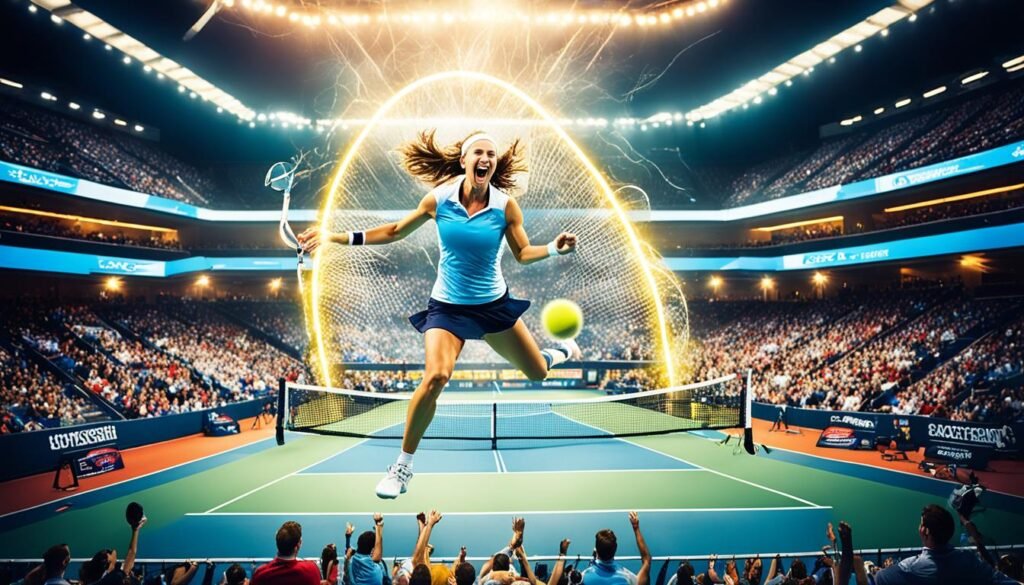
Indoor tournaments hold a special place in the tennis world, showcasing the abilities of players in a controlled environment. Two renowned indoor tournaments that attract top tennis talent are the Paris Masters and the ATP Finals.
When it comes to indoor tournaments, some players face unique challenges. Take Rafael Nadal, for example. While he has had tremendous success outdoors, the indoor setting presents a different playing experience for him. The controlled conditions and faster court surfaces require adaptability and adjustments to his game.
On the other hand, players like Roger Federer and Novak Djokovic have thrived in indoor tournaments. Known for their aggressive playing styles and powerful shots, they find success in the controlled environment of indoor courts. Their ability to generate consistent and accurate shots under these conditions has propelled them to victories in numerous indoor events.
Paris Masters
The Paris Masters is an important indoor tournament held annually in Paris, France. As part of the ATP Tour Masters 1000 series, it attracts top-ranked players competing for valuable ranking points and a chance to win the coveted title. The tournament is contested on indoor hard courts, offering a fast-paced and exciting spectacle for tennis fans.
With a rich history dating back to 1968, the Paris Masters has witnessed legendary battles on the indoor courts. Past champions include renowned players such as Andre Agassi, Boris Becker, and Novak Djokovic.
ATP Finals
The ATP Finals is the prestigious season-ending event that brings together the top eight singles players and doubles teams of the year. Held indoors, this tournament serves as the ultimate showdown, where the best of the best compete for the prestigious ATP Finals title.
Over the years, the ATP Finals has produced memorable matches and rivalries. Players like Roger Federer, Novak Djokovic, and Rafael Nadal have battled it out on the indoor courts, mesmerizing fans with their skill and determination.
Indoor tournaments like the Paris Masters and ATP Finals offer a unique platform for players to showcase their talents and compete against the best in the world. The controlled environment, combined with the intensity of the competition, sets the stage for thrilling matches and unforgettable moments in the world of tennis.
Locations
Locations can refer to physical places or coordinates on Earth’s surface, ranging from specific addresses to vast regions. They play a crucial role in navigation, communication, and understanding the world. Locations can hold historical, cultural, and economic significance, shaping human interactions and experiences. They encompass diverse environments, such as urban areas, rural landscapes, natural wonders, and artificial structures. Additionally, in the digital realm, locations extend to virtual spaces, websites, and online platforms. Overall, locations serve as the backdrop for human activities, serving as points of reference, connection, and exploration in both the physical and virtual worlds.
Court Reservations
Court reservations involve booking specific times for the use of facilities such as tennis courts, basketball courts, or other recreational spaces. These reservations ensure that individuals or groups have exclusive access to the court during their allotted time, preventing conflicts and overcrowding. They are commonly used in sports clubs, community centers, and recreational facilities to organize activities and manage resources efficiently. Court reservations may be made online, over the phone, or in person, often requiring payment or membership validation. This system helps maintain order and fairness, allowing people to enjoy their chosen activities without disruption or inconvenience.
Also Read: Advancing The Game With Tennis Innovators
Conclusion
Indoor tennis courts offer numerous advantages for players looking to enhance their game. The controlled conditions provide a consistent playing environment and allow tennis enthusiasts to enjoy the sport year-round. Additionally, indoor courts offer the advantage of playing without the interference of wind or the glare of the sun, allowing players to focus solely on their performance.
However, playing indoor tennis does come with its own set of challenges. Crowd noise and echoing can sometimes pose distractions, requiring players to maintain their focus and concentration during matches. Additionally, adapting to the indoor environment may affect player performance to some extent, as different nuances of the court and lighting can impact the trajectory and movement of the ball.
To excel in indoor tennis, players must understand and adapt to the unique conditions. By honing their skills to overcome challenges like noise and echo, and by capitalizing on the controlled environment, players can maximize their performance on indoor courts. With proper strategy, agility, and adaptability, players can make the most of the advantages that indoor tennis courts offer and elevate their game to new heights.
FAQs
Q: Where are the indoor tennis courts located?
A: The indoor tennis courts are located in California.
Q: How can I reserve a court for indoor tennis?
A: To reserve a court for indoor tennis, please call us to make a court reservation.
Q: What are the hours of operation for the indoor tennis courts?
A: The indoor tennis courts are open 6 days a week for your convenience.
Q: What is the price to rent an indoor tennis court for an hour?
A: The hourly rental price for an indoor tennis court is $20.
Q: How can I get the results of the latest tennis league matches?
A: To get the latest results of the tennis league matches, please wait for the update on our website.
Q: Are there private indoor tennis courts available for rent?
A: Yes, we offer private indoor tennis courts for rental to cater to your needs.
Q: Do the indoor tennis courts in California have state-of-the-art amenities?
A: Yes, our indoor tennis courts in California are equipped with state-of-the-art facilities for your enjoyment.
